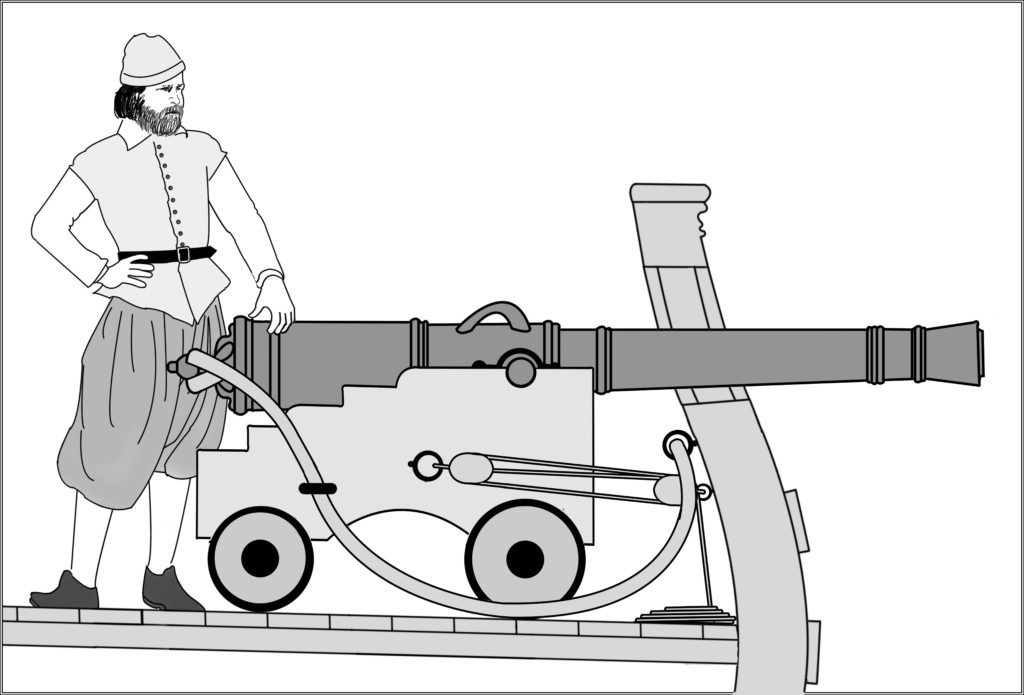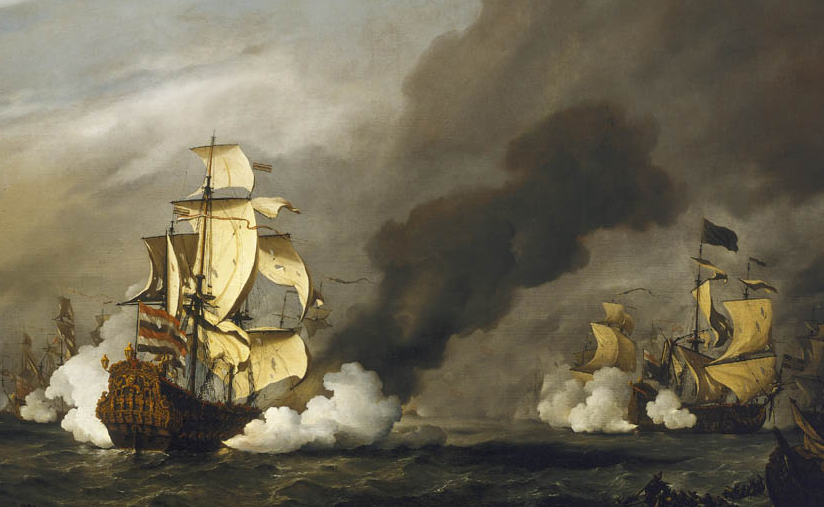Barbary corsair ships—like all pirate ships—were armed with cannon. The oared galleys that corsairs used in the Mediterranean had cannon mounted on the prow. Since the oars and the benches where the slave rowers toiled lined the sides of the ship, the prow was pretty much the only place to mount cannon. By the early seventeenth century, however, Barbary corsairs had begun to make extensive use of square-rigged European-style vessels (having been taught how to build, sail, and navigate them by European renegados), and they burst out of the Mediterranean into the Atlantic littoral and beyond. Square-rigged sailing ships mostly mounted their cannon on the sides of the ship rather than fore or aft—hence the famous “broadsides,” when all the cannon along one side of a ship were fired at once (see the illustration above).
Now, four hundred years later, we tend to think of all these ships—galleys and squared-rigged ships alike—as being armed simply with “cannon,” that is, with a single, generic type of weapon. In the early seventeenth century, though, people did not use the word “cannon” in the generic sense that we do today. The term was indeed used, but it referred to specific types of large guns: the cannon royal, the cannon, the demi-cannon. Beyond, that, there was a bewildering series of designations for what we think of as simply “cannons.” There were culverins and demi-culverins, sakers, minions, falcons, falconets, robinets (this list is based on English names; other languages had a different terminology). Not only were there numerous types of guns; there was considerable variation within types as well. This was the pre-industrial age, remember. There were no automated factories. Everything was handcrafted—which meant there was no widespread standardization. Individual examples of the gun known as a demi-cannon, for example, might weigh anywhere between 4,500 and 6,000 pounds (these were be big guns), have a barrel 10 – 12 feet long, and fire cannon balls weighing anything from 27 to 32 pounds.
This eccentric diversity can seem confusing at first, but as long as one allows for a degree of variation within each type, the different types of seventeenth century guns can be classified into a coherent enough system using a simple criterion: size. The chart below lists the major types, giving their names, weight, length of barrel, caliber of the shot (i.e., the diameter of the cannon ball shot by the gun) and the weight of the shot. This chart makes things seem more standardized than they really were, though. So it should be thought of as a useful but imperfect classification scheme rather than a definitive register of gun types.
| TYPE OF CANNON
|
WEIGHT | LENGTH | CALIBER OF SHOT | WEIGHT OF SHOT |
| Cannon Royal | 8,000 lbs
(3,630 kgs) |
8 feet
(2.4 meters) |
8 inches
(20 cms) |
63 – 68 lbs
(28.5 – 31 kgs) |
| Cannon | 6,000 – 7,000 lbs
(2,720 – 3,175 kgs) |
10 Feet
(3 meters) |
7 inches
(17.7 cms) |
40 – 47 lbs
(18 – 21 kgs) |
| Demi-Cannon | 4,500 – 6,000 lbs
(2,041 – 2,720 kgs) |
11 – 12 feet
(3.3 – 3.6 meters) |
6 inches
(15 cms) |
27 – 32 lbs
(12 – 14.5 kgs) |
| Culverin | 4,000 – 4,500 lbs
(1,814 – 2,041 kgs) |
11 – 12 feet
(3.3 – 3.6 meters) |
5 inches
(12.7 cms) |
15 – 18 lbs
(6.8 – 8 kgs) |
| Demi-Culverin | 3,000 – 3,600 lbs
(1,360 – 1,633 kgs) |
10 – 11 feet
(3 – 3.3 meters) |
4 ½ inches
(11.4 cms) |
8 – 9 lbs
(3.6 – 4 kgs) |
| Saker | 1,800 – 2,000 lbs
(816 – 907 kgs) |
7 – 9 feet
(2 – 2.7 meters) |
3 ½ inches
(8.9 cms) |
5 – 5 ½ lbs
(2.3 – 2.5 kgs) |
| Minion | 1,200–1,500 lbs
(544 – 680 kgs) |
6 – 8 feet
(1.8 – 2.4 meters) |
3 inches
(7.6 cms) |
3 ½ – 5 lbs
(1.6 – 2.2 kgs) |
| Falcon | 680 – 700 lbs
(308 – 318 kgs) |
6 feet
(1.8 meters) |
2 ½ inches
(6.3 cms) |
2 – 3 lbs
(0.9 – 1.4 kgs) |
| Falconet | 200 – 220 lbs
(90.5 – 99.7 kgs) |
4 feet
(1.2 meters) |
2 inches
(5 cms) |
1 ½ – 2 lbs
(0.7 – 0.9 kg) |
| Robinet | 150 – 300 lbs
(68 – 136 kgs) |
3 – 4 feet
(0.9 – 1.2 meters) |
1 ½ inches
(3.8 cms) |
1 ½ – 1 ¾ lbs
(0.7 – 0.8 kg) |
| Swivel Gun (Pattarero) | 100 – 250 lbs
(45 – 113 kgs) |
3 – 4 feet
(0.9 – 1.2 meters) |
1 – 2 inches
(2.5 – 5 cms) |
1 – 1 ½ lb
(0.45 – O.7 kg) |
As you can see, some of these guns were huge. To handle the largest of them all, the cannon royal, could take a crew of up to 16 men. The cannon balls for the cannon royal averaged about 65 pounds (30 kilograms) each. To fire off such a massive hunk of iron required a charge of 30 – 35 pounds (13.5 – 15 kilograms) of gunpowder. Only the very largest warships—150 feet (55 meters) or more in length—could employ these cannon royal. Such large warships might carry as many as 100 guns of varying sizes. A broadside from such a ship could inflict immense damage.
Barbary corsairs (and seventeenth century pirates in general), however, did not use such large ships. The vessels they sailed in usually did not exceed 80 or 90 feet (24 – 28 meters) in length, and were often smaller than that. Such relatively modest vessels were fast and nimble—qualities that mattered very much in a pirate vessel—but simply could not house the bigger types of cannon. It was rare that corsair ships employed anything much larger than minions. Minions were still serious artillery, though. They had the benefit of being far more maneuverable on deck than the larger guns, they could be handled by a team of just three or four men, and they could lob a 5-pound (2.2 kilogram) ball the better part of half a mile (750 meters).
The image below shows a cutaway view of a minion in situ on a ship’s deck. The barrel is depicted as being about 7 feet (2 meters) long. The figure standing next to the gun is in scale. This is about as large a gun as you would likely ever see aboard most square-rigged corsair ships.

A typical corsair ship night carry anywhere from 6 to 14 cannon, varying in size from the minion on downwards. Even with such relatively small guns, though, the supplies required to operate them could be significant. A list of expenses compiled by a corsair captain in Salé, Morocco, in the 1620s as he was outfitting his ship for an expedition includes the following:
____________________________________________________________
– For 15 quintals of gunpowder, at 15 ducats
per quintal……………………………………………………………dos 225
– For 10 quintals of cannon balls, at 3½ ducats
per quintal…..………………………………………………………..dos 35
____________________________________________________________
A quintal is equal to about 100 pounds (45 kilograms). So this corsair captain had to purchase 1,500 pounds (680 kilograms) of gunpowder and 1,000 pounds (455 kilograms) of cannon balls. And this impressive gunpowder/shot supply was likely required to support no more than a dozen or so cannon—perhaps fewer than that.
The total cost for equipping the guns aboard this ship—260 Barbary ducats (dos))—was significant. In the 1620s, a farm laborer in England earned about £8 to £10 a year; city laborers earned £10 to £14, skilled craftsmen £12 to £20. Urban London wages were higher: £18 for laborers and £30 for skilled craftsmen. The total of 260 ducats equals about £105 at 1620s exchange rates. That is the equivalent of about 13 years’ wages for an ordinary farm laborer and over three years’ wages for a skilled London craftsman—quite serious money.
Firing these old guns was not a particularly technical exercise, but it did require considerable skill. See the next blog post in this Cannons series (Cannons – Part 2) for an explanation of how to fire a seventeenth century ship’s cannon.

Corsairs and Captives
Narratives from the Age of the Barbary Pirates
View Amazon listing
The Travels of Reverend Ólafur Egilsson
The story of the Barbary corsair raid on Iceland in 1627
View Amazon listing